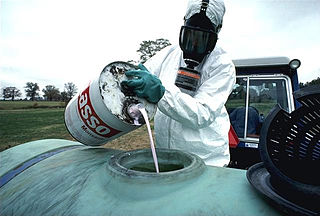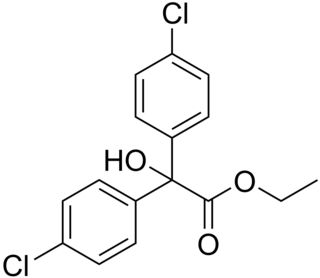This article has no lead section .(September 2018) (Learn how and when to remove this template message) |
Pesticides in the European Union
This article has no lead section .(September 2018) (Learn how and when to remove this template message) |
Pesticides in the European Union
In September 2008, the European Union issued new and revised Maximum Residue Limits (MRLs) in plants for the roughly 1,100 pesticides ever used in the world. The revision was intended to simplify the previous system, under which certain pesticide residues were regulated by the Commission, others were regulated by Member States, and others were not regulated at all. [1]
Environment of the European Union:

A pesticide, also called Plant Protection Product (PPP), which is a term used in regulatory documents, consists of several different components. The active ingredient in a pesticide is called “active substance” and these active substances either consist of chemicals or micro-organisms. The aims of these active substances are to specifically take action against organisms that are harmful to plants. In other words, active substances are the active components against pests and plant diseases.

Pesticides are substances that are meant to control pests, including weeds. The term pesticide includes all of the following: herbicide, insecticides nematicide, molluscicide, piscicide, avicide, rodenticide, bactericide, insect repellent, animal repellent, antimicrobial, and fungicide. The most common of these are herbicides which account for approximately 80% of all pesticide use. Most pesticides are intended to serve as plant protection products, which in general, protect plants from weeds, fungi, or insects.
The Canadian Food Inspection Agency (CFIA) is a regulatory agency that is dedicated to the safeguarding of food, animals, and plants, which enhance the health and well-being of Canada's people, environment and economy. The agency was created in April 1997 by the Canadian Food Inspection Agency Act for the purpose of combining and integrating the related inspection services of three separate federal government departments: Agriculture and Agri-Food Canada, Fisheries and Oceans Canada, and Health Canada. The establishment of the CFIA consolidated the delivery of all federal food safety, animal health, and plant health regulatory programs.

Carbofuran is one of the most toxic carbamate pesticides. It is marketed under the trade names Furadan, by FMC Corporation and Curater, among several others. It is used to control insects in a wide variety of field crops, including potatoes, corn and soybeans. It is a systemic insecticide, which means that the plant absorbs it through the roots, and from here the plant distributes it throughout its organs where insecticidal concentrations are attained. Carbofuran also has contact activity against pests.

The Codex Alimentarius is a collection of internationally recognized standards, codes of practice, guidelines, and other recommendations relating to foods, food production, and food safety.
Biopesticides, a contraction of 'biological pesticides', include several types of pest management intervention: through predatory, parasitic, or chemical relationships. The term has been associated historically with biological control – and by implication – the manipulation of living organisms. Regulatory positions can be influenced by public perceptions, thus:
Pesticide residue refers to the pesticides that may remain on or in food after they are applied to food crops. The maximum allowable levels of these residues in foods are often stipulated by regulatory bodies in many countries. Regulations such as pre-harvest intervals also often prevent harvest of crop or livestock products if recently treated in order to allow residue concentrations to decrease over time to safe levels before harvest. Exposure of the general population to these residues most commonly occurs through consumption of treated food sources, or being in close contact to areas treated with pesticides such as farms or lawns.

Glufosinate is a naturally occurring broad-spectrum systemic herbicide produced by several species of Streptomyces soil bacteria. Plants may also metabolize bialaphos, another naturally occurring herbicide, directly into glufosinate. The compound irreversibly inhibits glutamine synthetase, an enzyme necessary for the production of glutamine and for ammonia detoxification, giving it antibacterial, antifungal and herbicidal properties. Application of glufosinate to plants leads to reduced glutamine and elevated ammonia levels in tissues, halting photosynthesis, resulting in plant death.
The maximum residue limit, is the maximum amount of pesticide residue that is expected to remain on food products when a pesticide is used according to label directions, that will not be a concern to human health.

The impact of pesticides consists of the effects of pesticides on non-target species. Pesticides are chemical preparations used to kill fungal or animal pests. Over 98% of sprayed insecticides and 95% of herbicides reach a destination other than their target species, because they are sprayed or spread across entire agricultural fields. Runoff can carry pesticides into aquatic environments while wind can carry them to other fields, grazing areas, human settlements and undeveloped areas, potentially affecting other species. Other problems emerge from poor production, transport and storage practices. Over time, repeated application increases pest resistance, while its effects on other species can facilitate the pest's resurgence.

Clothianidin is an insecticide developed by Takeda Chemical Industries and Bayer AG. Similar to thiamethoxam and imidacloprid, it is a neonicotinoid. Neonicotinoids are a class of insecticides that are chemically similar to nicotine, which has been used as a pesticide since the late 1700s. Clothianidin and other neonicotinoids act on the central nervous system of insects as an agonist of acetylcholine, the neurotransmitter that stimulates nAChR, targeting the same receptor site (AChR) and activating post-synaptic acetylcholine receptors but not inhibiting AChE. Clothianidin and other neonicotinoids were developed to last longer than nicotine, which is more toxic and which breaks down too quickly in the environment. However, studies published in 2012 show that neonicotinoid dust released at planting time may persist in nearby fields for several years and be taken up into non-target plants, which are then foraged by bees and other insects.

Phoxim is an organophosphate insecticide that is produced by the Bayer corporation. It is an analogous dimethyl ester and an organothiophosphate acaricide. It is allowed for use in limited applications in the European Union. It is banned for use on crops in the European Union since 22 December 2007.

Propachlor (2-chloro-N-isopropylacetanilide) is an herbicide first marketed by Monsanto. It was registered for use in the United States during 1965.

The California Department of Pesticide Regulation, also known as DPR or CDPR, is one of six boards and departments of the California Environmental Protection Agency (Cal/EPA).

Chlorobenzilate is a pesticide that is not currently used in the United States or Europe. It was originally developed by Ciba-Geigy and introduced in 1952. It was used as an acaricide against mites on citrus trees, including deciduous fruit trees. It has been detected as a residue on tomatoes found in Japanese markets in 2005. It is a non-systemic pesticide that works through contact and as a neurotoxin: it disrupts the functioning of the nervous system.

Thiamethoxam is a systemic insecticide in the class of neonicotinoids. It has a broad spectrum of activity against many types of insects.
Down to Earth is Asia's premier fortnightly on politics of environment and development assisted by the Centre for Science and Environment and published from New Delhi, India. It was started in 1992 by environmentalist the late Anil Agarwal, with a commitment to make people aware of the challenges of environment and development and to create informed change agents. Sunita Narain a leading Indian environmentalist and director general of the Centre for Science and Environment is editor of this fortnightly magazine.

Carbosulfan is an organic compound adherent to the carbamate class. At normal conditions, it is brown viscous liquid. It is not very stable; it decomposes slowly at room temperature. Its solubility in water is low but it is miscible with xylene, hexane, chloroform, dichloromethane, methanol and acetone. Carbosulfan is used as an insecticide. The European Union banned use of carbosulfan in 2007.
A Bioeffector is a viable microorganism or active natural compound which directly or indirectly affects plant performance (Biofertilizer), and thus has the potential to reduce fertilizer and pesticide use in crop production.
Pesticide standard values are applied worldwide to control pesticide pollution, since pesticides are largely applied in numerous agricultural, commercial, residential, and industrial applications. Usually, pesticide standard value is regulated in residential surface soil, drinking water, foods, and other ecological sections.